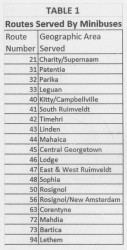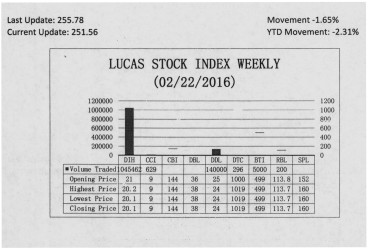Part 3
Movement of people and goods
The previous sections of this article have sought to show that the road transport market is multidimensional and carries different risks for each income-generating sector of the market. Being the most developed in Guyana, road transport is critical to the movement of people and goods within the country. All sectors depend on road transportation, therefore, it occupies an important part of the supply chain within and across industries. With 
Structure of minibus transport industry
Unlike the car segment of the road transport market, the minibus market in Guyana has some special features. Therefore, it would be useful to first describe the structure of the minibus market before discussing its economic and social implications. The minibus market has been segregated into 19 parts. These parts are called routes and give passengers an idea of the geographic spread of the minibus service across the country. The routing system helps to set up the structure of the minibus transport industry and influences the extent of competition. The regional system seems to play a role in defining the 19 markets that make up the minibus service industry, even though this is not confirmed by the police. The structure of the industry is identified by routes which are based on a numbering system that, with the exception of Linden and Mahdia, appears to follow a regional model. The Table below provides an indication of the way the route classification patterns itself off of the identification of regions in Guyana. The utility of this numbering system is that it could serve also as a model for issuing vehicle licence plates for all vehicles by the Guyana Revenue Authority (GRA) from decentralized regional locations.
Routing system and route allocation

The route allocation appears to be influenced by the population distribution of the country as well. The market with the larger number of routes is where the larger number of people lives. Without considering adequacy, the allocation of multiple routes in Region 4 makes sense, since it is the most populated region in the country with 42 per cent of the nation’s population. As a result, Georgetown and its suburbs have six of the eight routes that serve Region 4. This also makes sense since the area has a population of about 119,000 people according to the Preliminary Report on the 2012 Census.
The Census Report also disclosed that Georgetown itself has a population of about 25,000 people. The principal urban centre in Region 2, Anna Regina, has half the population of the City of Georgetown. Yet, it only has one minibus route. This might be partly explained by the reality that there is one main road between Charity and Supenaam. Region 3 has three routes, one for the west bank of the Demerara River, one for the west coast of Demerara and that reaches to Parika on the east bank of the Essequibo River, one on the island of Leguan. Regions 7, 8 and 9 have one route each. Regions 5 and 6 have one exclusive route each and one shared route. Region 5 has the Georgetown to Rosignol route while Region 6 has the Corentyne route. The two regions share the Rosignol to New Amsterdam route. To a large extent, the routing system also reflects the undeveloped nature of the road network and the spatial distribution of the population.
Most highly regulated
The minibus market is the most highly regulated of the road service providers. There are in excess of 6,000 minibuses serving the 19 markets with an

The Lucas Stock Index (LSI) fell 1.65 percent during the fourth period of trading in February 2016. The stocks of six companies were traded with 1,191,587 shares changing hands. There was one Climber and four Tumblers. The stocks of Demerara Tobacco Company (DTC) rose 1.9 percent on the sale of 296 shares. At the same time, the stocks of Banks DIH (DIH) fell 4.29 percent on the sale of 1,045,462 shares; the stocks of Demerara Distillers Limited (DDL) fell 4 percent on the sale of 140,000 shares; the stocks of Guyana Bank for Trade and Industry (BTI) fell 5.81 percent on the sale of 5,000 shares and the stocks of Republic Bank Limited (RBL) fell 0.09 percent on the sale of 200 shares. In the meanwhile, the stocks of Caribbean Container Inc. remained unchanged on the sale of 629 shares.
estimated payload capacity of 90,000 passengers. This works out to an average of 333 minibuses serving each market. The motive for regulating the minibus market is unclear, but practices in that area have had a profound effect on road use and on industry behaviour. The restrictions on the industry are many.
The principal regulator of the minibus industry is the Ministry of Public Security which administers the responsibility through the Traffic Department of the Guyana Police Force. The police issue the routes which buses serve. Except in the three instances of routes 21, 33 and 56, Demerara also serves as the focal point for the minibuses. This means that all minibuses can originate and end their service in Demerara. Also, they can do so at either extreme points of their route or any of the places along the route that they serve. For example, a minibus that serves the Georgetown-Mahaica route can start its journey in Georgetown or Mahaica. It can also start and stop its journey in Buxton or Enterprise or any other village that lies between the two extreme points of Georgetown and Mahaica. There is the particular case of some buses on the 44 route that start and stop service at the University of Guyana’s Turkeyen Campus. Also, some Route 42 buses take their service up to Grove on the East Bank of Demerara and not all the way to Timehri.
Buses cannot be found outside of their route without receiving permission from the GPF. To deviate from their route, buses must receive a pass to cover the period that they wish to operate outside of their route. They cannot solicit passengers while operating temporarily outside of their route.
The GPF segregates the market, thereby ensuring that there was no national market for minibus services. By creating a series of segregated markets, it has shielded regions from competition with each other. The GPF also provides the road service licence and pronounces on the fitness for the buses. (The fourth and final part will be presented next week.)





